
JOURNAL OF THE OPTICAL SOCIETY OF AMERICA A-OPTICS IMAGE SCIENCE AND VISION
Scope & Guideline
Pioneering Discoveries in Image Science and Vision
Introduction
Aims and Scopes
- Optical Imaging and Vision Science:
Research on imaging techniques, including digital holography, adaptive optics, and image processing methods that enhance visual perception and understanding. - Wavefront Sensing and Aberration Correction:
Studies focusing on wavefront analysis, sensor development, and correction methodologies to improve optical system performance. - Polarization and Coherence:
Investigations into the properties of polarized light and coherence in optical systems, which are crucial for applications in imaging and communication. - Nanophotonics and Plasmonics:
Exploration of light-matter interactions at the nanoscale, including the use of photonic crystals and plasmonic structures for sensing and imaging. - Computational Optics:
Application of computational techniques to solve complex optical problems, including machine learning approaches for image reconstruction and analysis. - Nonlinear and Quantum Optics:
Research on nonlinear optical phenomena and quantum optics that expands the understanding of light behavior in various media.
Trending and Emerging
- Machine Learning in Optics:
An increasing number of publications are utilizing machine learning techniques for image processing, classification, and reconstruction, showcasing the integration of artificial intelligence into optical research. - Advanced Imaging Techniques:
Research focusing on novel imaging methodologies, such as digital holography, 3D imaging, and multispectral imaging, is on the rise, driven by the demand for more precise and versatile imaging solutions. - Optical Communication in Turbulent Environments:
There is a growing interest in developing optical communication systems that can operate effectively in challenging environments, such as underwater or atmospheric turbulence, which is critical for future communication technologies. - Biomedical Applications of Optics:
The journal is increasingly publishing research that applies optical techniques to biomedical fields, including imaging, diagnostics, and therapy, reflecting the interdisciplinary nature of current optical research. - Plasmonic and Metamaterial Research:
Research on plasmonics and metamaterials is trending, focusing on their applications in sensors and imaging systems, indicative of the ongoing interest in nanophotonics.
Declining or Waning
- Traditional Optical Systems Design:
Research related to conventional optical system design, such as basic lens systems and simple optical components, has seen reduced publication frequency, possibly due to advancements in computational and adaptive optics. - Basic Interferometry Techniques:
Classic interferometry methods, while still foundational, are being overshadowed by more advanced techniques that incorporate machine learning and computational approaches. - Static Imaging Techniques:
Static imaging methods that do not adapt to dynamic environments or conditions are less frequently explored, as the field moves toward more sophisticated imaging systems capable of handling real-time data.
Similar Journals

Journal of Optics-India
Exploring the Depths of Optical KnowledgeThe Journal of Optics-India, published by SPRINGER INDIA, serves as a vital platform dedicated to advancing research in the field of optics, focusing on topics in both atomic and molecular physics. With an ISSN of 0972-8821 and an E-ISSN of 0974-6900, the journal has been a consistent contributor to the field since its inception in 1996 and continues to thrive with its anticipated convergence through 2024. Although currently classified in Q3 of the 2023 category quartiles, the journal actively seeks to elevate its standing within Scopus rankings in physics and astronomy, where it holds a rank of 143/224, indicating significant opportunities for growth and research impact. The Journal of Optics-India is committed to fostering innovative research and providing scholars and practitioners with access to cutting-edge findings, thereby enhancing global conversations around optics and its vast applications. As a reliable source for researchers, professionals, and students alike, the journal emphasizes quality contributions that shape the future of optical science.
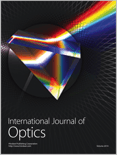
International Journal of Optics
Illuminating the Future of OpticsWelcome to the International Journal of Optics, a distinguished publication dedicated to advancing the field of optics and its interdisciplinary applications. Published by HINDAWI LTD, this open-access journal has been pivotal in fostering knowledge since its inception in 2009. With a robust focus on atomic and molecular physics as well as electronic, optical, and magnetic materials, the journal has carved its niche within Q3 quartile rankings in these categories for 2023, signifying its growing impact and relevance in the scientific community. Researchers and professionals will find a rich repository of innovative and cutting-edge research articles that not only address fundamental aspects of optics but also explore practical applications across various domains. The journal's aim is to promote high-quality research dissemination, enhancing collaboration among scientists and ensuring that pivotal findings reach a global audience. Join us in exploring the dynamic world of optics—where your contributions help shape the future of science.
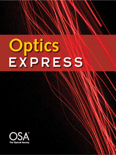
OPTICS EXPRESS
Connecting Researchers in the World of OpticsOPTICS EXPRESS is a premier peer-reviewed journal published by the Optica Publishing Group, specializing in the rapidly evolving fields of Atomic and Molecular Physics and Optics. With an impressive Q1 ranking in its category and positioned in the 75th percentile among leading journals in Physics and Astronomy, OPTICS EXPRESS serves as a vital platform for disseminating innovative research findings. Since its inception in 1997 and transitioning to Open Access in 1998, the journal has ensured that groundbreaking scientific contributions are accessible to a global audience, fostering collaboration and advancement in optical science. Additionally, with annual publications converging from 1997 to 2024, this journal not only tracks the latest advancements but also shapes the future landscape of optics research. Whether you are a seasoned researcher, a dedicated professional, or a passionate student, OPTICS EXPRESS offers a wealth of knowledge and a commitment to excellence in the optics community.
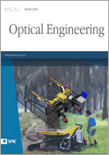
OPTICAL ENGINEERING
Pioneering breakthroughs in optics and imaging.OPTICAL ENGINEERING, published by SPIE-SOC PHOTO-OPTICAL INSTRUMENTATION ENGINEERS, is a premier journal in the field of optical and photonic engineering, dedicated to advancing the science and technology of optics, photonics, and imaging systems. With ISSN 0091-3286 and E-ISSN 1560-2303, this esteemed publication has been contributing to the academic community since its inception in 1972, covering a wide array of topics within its converged years of operation. As a recognized entity, the journal is presently positioned in the Q3 quartile for Atomic and Molecular Physics and Optics, and in the Q2 quartile for Engineering (miscellaneous) as of 2023. The journal’s Scopus ranks reflect its impact and significance, being placed at #129 out of 307 in General Engineering and #137 out of 224 in Atomic and Molecular Physics. Although it does not operate under an open access model, the journal remains a vital resource for researchers, professionals, and students seeking the latest advancements in optical engineering. With a focus on publishing innovative research and technical advancements, OPTICAL ENGINEERING continues to be essential for driving progress in this crucial scientific field.

Nonlinear Optics Quantum Optics-Concepts in Modern Optics
Pioneering Insights in Modern Optical ResearchNonlinear Optics Quantum Optics-Concepts in Modern Optics is a specialized journal published by OLD CITY PUBLISHING INC, focusing on the forefront of research in nonlinear optics and quantum optics. With an ISSN of 1543-0537 and an E-ISSN of 1944-8325, this journal serves as a pivotal platform for the dissemination of innovative concepts and findings in modern optics, significant for both theoretical exploration and practical applications. Established in 2003, the journal's scope encompasses critical areas such as atomic and molecular physics, optical materials, and instrumentation, attracting submissions from a diverse range of interdisciplinary fields. While the journal currently maintains a Q4 ranking in several categories, it continues to strive for higher visibility and impact in the academic community. Researchers and students alike will find valuable insights and contributions that foster advancements in optical science and engineering. With an emphasis on rigorous peer-review, Nonlinear Optics Quantum Optics-Concepts in Modern Optics is committed to enhancing the understanding and application of nonlinear optical phenomena in various technological domains.

Optica
Empowering discoveries in Atomic and Molecular Physics.Optica is a premier open-access journal published by the Optica Publishing Group, designed to disseminate high-quality research across the fields of Atomic and Molecular Physics and Optics. Since its inception in 2014, it has established itself as a vital resource for the scientific community, as evidenced by its impressive Q1 rankings in both relevant categories in 2023 and its notable positions in the Scopus rankings—#9 in Atomic and Molecular Physics and #13 in Materials Science. Featuring cutting-edge research from leading experts, Optica aims to foster innovation and collaboration by providing unrestricted access to groundbreaking discoveries and advancements. Researchers, professionals, and students alike will find invaluable insights and trends that drive the ever-evolving scope of optical science and materials technology. With its commitment to open access, Optica ensures that knowledge is accessible, empowering the global community of scientists and researchers to embark on new explorations.

Optics Continuum
Pioneering Discoveries in Light and MaterialsOptics Continuum, published by Optica Publishing Group, is a pioneering open access journal dedicated to advancing the field of optics and photonics. Since its inception in 2022, this journal seeks to provide a vital platform for the dissemination of groundbreaking research and innovative developments across several interconnected domains, including electrical and electronic engineering, atomic and molecular physics, and material sciences focused on electronic, optical, and magnetic materials. With impressive rankings in Scopus—placed #384 in Electrical and Electronic Engineering and #109 in Atomic and Molecular Physics—the journal aims to engage a diverse readership comprised of researchers, professionals, and students, promoting collaboration and knowledge exchange. The journal's open access model ensures that cutting-edge research is readily available to all, nurturing an inclusive academic environment. For those interested in staying at the forefront of optics research, Optics Continuum is an essential resource that continuously enriches the global scientific community.
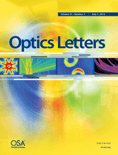
OPTICS LETTERS
Illuminating the Future of Optical ResearchOPTICS LETTERS is a premier academic journal published by the Optica Publishing Group, dedicated to advancing the field of optics and photonics. Since its inception in 1977, it has maintained a strong reputation for publishing high-impact research, holding a distinguished Q1 category ranking in Atomic and Molecular Physics, as well as Optics, making it a vital resource for researchers and professionals alike. With an impressive Scopus rank of #55 out of 224 in its field, OPTICS LETTERS continues to shape the discourse and innovation in optical science. Authors benefit from its extensive international reach, while readers gain access to cutting-edge studies that address both theoretical and applied aspects of optics. Although the journal currently does not offer open access options, its rigorous peer-review standards ensure that every publication meets the highest academic criteria, making it an essential journal for anyone looking to stay at the forefront of optical research.
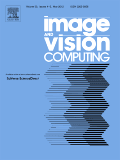
IMAGE AND VISION COMPUTING
Pioneering research at the intersection of vision and computation.Image and Vision Computing, published by Elsevier, serves as a leading international journal focused on the dynamic fields of computer vision, pattern recognition, and signal processing. With its esteemed Q1 category rankings in these areas and an impressive standing in Scopus metrics, where it ranks 19th in Computer Vision and 23rd in Signal Processing, this journal has firmly positioned itself at the forefront of academic research and innovation. Established in 1983, it continues to publish cutting-edge research that drives advancements in technology and applications across various domains. The journal is committed to disseminating high-quality, peer-reviewed articles that address significant challenges and propose novel solutions, making it an essential resource for researchers, practitioners, and students alike. While not an open access journal, Image and Vision Computing offers a wealth of valuable insights into the ever-evolving landscape of visual computing technologies.

Chinese Optics
Advancing the Frontiers of Light and Knowledge.Chinese Optics is a premier journal dedicated to advancing the field of optics, encompassing research on atomic and molecular physics. Published by the esteemed Changchun Institute of Optics Fine Mechanics & Physics in China, this journal supports the sharing of cutting-edge findings since its inception in 2010. With an ISSN of 2097-1842, it operates within a competitive landscape, currently positioned in Q3 of the category for Atomic and Molecular Physics and Optics, according to the 2023 metrics. While the journal is not open access, it offers a valuable platform for researchers, professionals, and students to explore and contribute to significant discoveries in the realm of optics and light technology. By fostering scholarly communication, Chinese Optics plays a crucial role in bridging theoretical and practical aspects, making it an indispensable resource for those passionate about the optical sciences.